
WGNBPW200A
WIC787890
Doc# L-03423, Rev.1
• 5-Year
Limited Warranty
AUTOMATIC WRIST
Blood Pressure
Monitor
IMPORTANT PRODUCT NOTICES
AND SAFETY INSTRUCTIONS
When using your blood pressure monitor, basic precautions should
always be followed. Please read and follow all instructions and
warnings before using this product. Save these instructions for future
reference.
• This device is intended for indoor, home use.
• This device is not intended for public use.
• This device is portable, but it is not intended for use during
patient transport.
• This device is not suitable for continuous monitoring during medical
emergencies or operations.
• This device is intended for no-invasive measuring and monitoring
of arterial blood pressure. It is not intended for use on extremities
other than the wrist, or for any purpose other than obtaining a blood
pressure measurement.
• This device is for adults. Do not use this device on neonates or
infants. Do not use it on children unless otherwise instructed by a
medical professional.
• Not for use on pregnant women, especially those in preeclampsia.
• The device is not suitable for use on patients with implanted,
electrical devices, such as cardiac pacemakers, defibrillators.
• The effectiveness of this device has not been established for use:
–on users with common arrhythmias such as atrial or ventricular
premature beats or atrial fibrillation,
–on users with peripheral arterial disease,
–on users undergoing intravascular therapy, or with arteriovenous
(AV) shunt.
Consult a medical professional before use.
• DO NOT use this device for diagnosis or treatment of any health
problem or disease. Contact your physician if you have or suspect
any medical problem. Do not change your medications without the
advice of your physician or health care professional.
• If you are taking medication, consult your physician to determine the
proper time to measure your blood pressure.
• This device may be used only for the intended use described in this
manual, the manufacturer shall have no liability for any incidental,
consequential, or special damages caused by misuse or abuse.
• Report any unexpected operation or events to the manufacturer.
• DO NOT apply the cuff on a wrist that has a intravenous drip or a
blood transfusion attached.
• WARNING: Taking blood pressure measurements too frequently
could disrupt blood circulation and cause injuries.
• WARNING: Do not apply cuff to areas on patient where skin is
delicate or damaged. Check cuff site frequently for irritation.
• WARNING: Do not place the cuff on the wrist of a person whose
arteries or veins are undergoing medical treatment, i.e. intra-vascular
access or intra-vascular therapy or an arteriovenous (A-V) shunt,
which could disrupt blood circulation and cause injuries.
• DO NOT place the cuff on the wrist on the same side of a
mastectomy (especially when lymph nodes have been removed).
It is recommended to take measurements on the unaffected side.
• DO NOT wrap the cuff on the same wrist to which another monitoring
device is applied. One or both devices could temporarily stop
functioning if you try to use them at the same time.
• Please check that the operation of the device do not result in
prolonged impairment of patient blood circulation.
• WARNING: On the rare occasion of a fault causing the cuff to
remain fully inflated during measurement, loosen and remove the
cuff immediately. Prolonged high pressure applied to the wrist (cuff
pressure >300 mmHg or constant pressure >15 mmHg for more
than 3 minutes) might lead to bruising and discolored skin.
• WARNING: Do not use this device with high-frequency (HF) surgical
equipment at the same time.
• WARNING: This device is not AP/APG equipment. Do not use the
device where flammable anesthetic are present, or in environments
with a mixture of air with oxygen or nitrous oxide.
ABOUT BLOOD PRESSURE
What is Blood Pressure?
Blood pressure is the pressure exerted on the artery walls while
blood flows through the arteries. The pressure measured when the
heart contracts and sends blood out of the heart is systolic (highest)
blood pressure. The pressure measured when the heart dilates with
blood flowing back into the heart is called diastolic (lowest) blood
pressure. Both the systolic and diastolic pressure are necessary for
a physician to evaluate the status of a patient’s blood pressure.
Why Measure Your Blood Pressure?
Among today’s various health problems, those associated with high
blood pressure are very common. High blood pressure dangerously
correlates with cardiovascular disease. Therefore, blood pressure
monitoring is important for identifying those at risk.
Why Do My Readings Vary?
Blood pressure is a body parameter that is subject to normal
variations throughout the day. A single reading that is different from
yours or your doctor’s readings are not necessarily inaccurate. The
average of several readings, taken under similar conditions, using
the same wrist, is preferred for accurate blood pressure readings.
Why Are My Readings Different Than Those Taken at My
Doctor’s Office?
Many experience a phenomenon called “White Coat Hypertension”
when measured by a doctor. White Coat Hypertension refers to
blood pressure that rises above its usual level when measured in
a clinical setting, such as a doctor’s office.
BLOOD PRESSURE STANDARD
This table contains defined levels for hypertension that are publicly
available from the American Heart Association
®
(AHA 2017). Users
can compare their own blood pressure readings against these
defined levels to determine if there is a potential increased risk.
This table is applicable to most adults aged 18 and older.
Blood pressure tends to go up and down, even in people who normally
don’t have high readings. If your numbers stay above the normal range
most of the time, you may be at an increased risk and should consult
your physician.
Although one can easily find where their own blood pressure readings
fall on this table, this monitor comes equipped with a Risk Category
Index that automatically compares each reading to the defined levels
and provides a helpful cue if your reading falls into one of the stages
that could potentially indicate increased risk. See Risk Category Index
section for more information on this feature.
Please note that cues provided by this monitor are only intended to
assist you in using this table. The table and cues are only provided
for convenience to help you understand your noninvasive blood
pressure reading as it relates to the American Heart Association
®
information. They are not a substitute for a medical examination by
your physician. It is important for you to consult with your physician
regularly. Your physician will tell you your normal blood pressure
range as well as the point at which you may actually be considered
to be at risk.
Blood Pressure Category
Systolic
mmHg (upper
number)
Diastolic
mmHg (lower
number)
Indicator
Color
Normal <120 and <80 Green
Elevated 120–129 and <80 Yellow
High Blood Pressure
(hypertension) Stage 1
130–139 or 80–89
Red
High Blood Pressure
(hypertension) Stage 2
≥
140 or
≥
90
Hypertensive Crisis
(consult your doctor immediately)
>180 and/or >120
*Source: AHA 2017
NAME/FUNCTION OF EACH PART
NOTE:
The “MEM” button is also used to set the date and time.
Other Accessories:
2 “AAA” 1.5V alkaline
batteries (included)
START/STOP
Wrist Cuff
Battery Cover
(Located on
bottom of unit)
LCD
Display
Date & Time SetMemory Recall/
Date & Time Select
DISPLAY EXPLANATIONS
Date/Time
Indicator
Diastolic
Pressure
Systolic
Pressure
Heart Rate
Irregular
Heartbeat
Detector
Low Battery Symbol: Appears when batteries should be
replaced, or when +/- polarities have been positioned incorrectly.
Pulse Symbol: Shows heart rate in beats per minute.
Irregular Heartbeat Detector: Irregular heartbeat detected
during measurement. See Irregular Heartbeat Detector section
for more information.
Risk Category Index: Indicates the blood pressure level.
See Risk Category Index section for more information.
Memory Average: Displays average of last 3 readings.
Excessive Body Motion Detector: Appears when
excessive body movement, especially of the wrist the cuff is
worn, is detected during the measurement. See Excessive
Body Motion Detector section for more information. NOTE:
The measured blood pressure reading may not be accurate if the
icon is displayed.
Display Symbols:
Incorrect cuff placement: Correct and measure again.
Error Determining Measurement Data: Relax, do not
move, and measure again.
Error Determining Measurement Data: Wrap the cuff
properly, keep steady, and measure again.
Pulse Signal Not Detected: Relax for 3 minutes, measure again.
System Error: Turn off monitor and measure again. If EE still
appears on the display followed by any other character (ex:
EE4, EEA, etc.), please contact Consumer Relations.
Pressure Measurement Out of Range: Switch the unit off
to clear, then measure again.
If any of the following letters and numbers appear in the area
that systolic pressure should be displayed, an error has occurred
with your reading. See Troubleshooting section of this manual for
more information.
INSTALLING BATTERIES
1. Slide off the battery cover to open the
battery compartment.
2. Install or replace the 2 “AAA” alkaline
batteries according to the indications
inside the battery compartment.
NOTE:
When removing batteries, pull black ribbon forward.
3. Replace the battery cover.
Replace the batteries if:
• The low battery symbol appears on the display.
• When any button is pressed and nothing is displayed on the screen.
NOTE:
• Date and time will need to be reset if batteries are removed or replaced.
• Replace all batteries at one time (as simultaneous set). Do not
mix old and new batteries.
• Use only 1.5V “AAA” alkaline batteries. Do not mix alkaline, standard
(carbon-zinc) or rechargeable (Ni-Cad, Ni-MH, etc.) batteries.
• When installing batteries, observe proper +/- polarities. Incorrect
installation of batteries may cause damage to the unit.
• Remove batteries when unit is not in use for extended periods of time.
• When the batteries are removed, the measurement values stored in
memory are retained. However, the date and time must be reset.
• Clean contacts on battery and in battery compartment with a soft
dry cloth each time you install batteries.
• Keep batteries away from children as they could pose a choking hazard.
• Recycle or dispose of properly in accordance with all local, state,
province, and country regulations.
• Batteries are hazardous waste. DO NOT dispose of them
together with the household garbage.
• DO NOT dispose of batteries in fire. Batteries may explode or leak.
DATE & TIME SET PROCEDURE
It is important to set the Date & Time before using your blood
pressure monitor, so that a time stamp can be assigned to each
record that is stored in the memory.
1. To set the date and time, press the
“Date & Time Set” button.
2. The display will show a blinking number representing the
MONTH. Change the MONTH by pressing the “MEM” button.
Each press will increase the number by one in a cycling manner.
Press the
button to confirm the entry. The screen will then
show a blinking number representing the DAY.
3. Change the DAY, YEAR, HOUR, & MINUTE as described in Step
2 above, using the “MEM” button to change the numbers and
the
button to confirm the entries.
Repeat process to set DAY, YEAR, HOUR, and MINUTE.
Press the button
“MEM”
Blinking Month
Increase Month
Confirm Entry
IMPORTANT: IF YOU ARE USING THIS BLOOD PRESSURE MONITOR FOR THE FIRST
TIME, PLEASE REMOVE THE PROTECTIVE FILM FROM THE DISPLAY SCREEN.
APPLYING THE CUFF
1. Remove all watches, wrist jewelry, etc.
prior to attaching the wrist monitor.
Clothing sleeves should be rolled up
and the cuff should be wrapped around
bare skin for correct measurements.
2. Apply cuff to left wrist with palm facing
up as shown in Fig. A.
3. Make sure the edge of the cuff is about
1/4"–1/2" (1cm–1.5cm) from the palm
as shown in Fig. B.
4. In order to ensure accurate
measurements, fasten the hook and
loop strap securely around your wrist
so there is no extra space between
the cuff and the wrist. If the cuff
is not wrapped tight enough, the
measurement values will not
be accurate.
5. If your physician has diagnosed you
with poor circulation in your left arm,
place the cuff around your right wrist
as shown in Fig. C.
NOTE:
• This device should not be used when
your wrist is wounded or injured.
• If it is not possible to use the cuff on
your left wrist, it can also be used
on your right wrist. However, all
measurements should be made
using the same wrist.
START/STOP
MEM
START/STOP
MEM
START/STOP
MEM
START/STOP
MEM
Fig. B
START/STOP
MEM
START/STOP
MEM
START/STOP
MEM
Fig. C
Fig. A
CORRECT MEASUREMENT POSTURE
1. Place your elbow on a table so that the cuff
is at the same level as your heart as shown
in Fig. A. Relax your entire body, especially
between your elbow and fingers.
NOTE:
Your heart is located slightly below your armpit.
2. If the cuff is not at the same level as your
heart or if you cannot keep your arm
completely still throughout the reading,
use a soft object, such as a folded towel,
to support your wrist as shown in Fig. B.
3. Turn your palm upwards.
4. Sit upright in a chair with feet flat on the
floor and take 5-6 deep breaths. Do not
cross your legs. Keep your back against
the backrest of the chair. Avoid leaning
back while the measurement is
taken as shown in Fig. C.
Fig. A
Fig. B
Fig. C
(X)
HOW THIS BLOOD PRESSURE
MONITOR WORKS
This monitor uses innovative GentleInflate
®
technology to measure
your blood pressure. With one touch of a button, the monitor
automatically takes the reading during inflation, then deflates,
delivering a quick, comfortable, and quiet measurement every time.
Please note that any muscle movement during inflation will cause
measurement error. When measurement is complete, the monitor
will display your systolic pressure, diastolic pressure, and pulse
readings.
The monitor automatically finds where your measurement results fall
on the American Heart Association
®
(AHA 2017) table and provides
a cue if your reading falls into one of the stages that could
potentially indicate increased risk. Please refer to Risk Category
Index section for more information on this feature.
The appearance of the
icon indicates that a pulse irregularity
consistent with an irregular heartbeat was detected during
measurement. Refer to Irregular Heartbeat Detector section for more
information on the Irregular Heartbeat Detector.
• The device contains sensitive electronic components. To avoid
measurement errors, avoid taking blood pressure measurements
near a strong electromagnetic field radiated interference signal or
electrical fast transient/burst signal.
• Wireless communication equipment, such as wireless home network
devices, mobile phones, cordless telephones and their base stations,
walkie-talkies may cause interference that may affect the accuracy
of measurements. A minimum distance of 1 foot (30 cm) should be
kept from such devices during a measurement.
• You can use this device to take your own measurement, no third-
party operator is required.
• Please use the device under the environment which is provided in
the user manual. Otherwise, the performance and lifetime of the
device will be impacted and reduced.
• The device may require up to 30 minutes to warm up / cool down
from the minimum / maximum storage temperature before it is ready
for use.
• WARNING: Do not touch output of the batteries and the user
simultaneously.
• WARNING: The power cord is considered the disconnect device
for isolating this equipment from supply mains. Do not position the
equipment so that it is difficult to reach or disconnect.
• The blood pressure monitor and the cuff are suitable for use within
the patient environment.
• WARNING: Do not use this device if you are allergic to polyester,
nylon, or plastic.
• WARNING: Only use accessories approved by manufacturer. Using
unapproved accessories might cause damage to the unit and
injure users.
• WARNING: If you experience discomfort during a measurement,
such as pain in the wrist or other complaints, press the Power button
immediately to release the air from the cuff.
• No calibration is required within two years of reliable service.
• DO NOT attempt to repair the unit yourself if it malfunctions. In the
event that the device needs to be checked for calibration or replaced,
contact the distributor.
• Store your device, cuff in a clean and dry place, protect it against
extreme moisture, heat, lint, dust and direct sunlight. Never place any
heavy objects on it.
• WARNING: Keep the device, cuff, and batteries away from children as
they may pose a risk of choking or strangulation if used improperly.
• Clean both device and cuff with a soft, dry cloth. If necessary use a
dampened cloth and natural detergent. Do not use alcohol, benzene,
or other harsh chemicals.
• DO NOT wash the cuff in a washing machine or dishwasher!
• The service life of the cuff may vary by the frequency of washing, skin
condition, and storage state. The typical service life is 10000 times.
• Dispose of accessories, detachable parts, and the device according
to the local guidelines.Use only 1.5V “AAA” alkaline batteries for
power supply.
Blood pressure measurements determined with this device are
equivalent to those obtained by a trained observer using the cuff/
stethoscope auscultatory method, within the accuracy limits prescribed
by the American National Standard, manual, electronic, or automated
sphygmomanometers. The sphygmomanometer was clinically
investigated according to the requirement of ISO 81060-2:2013.




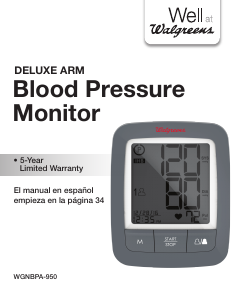
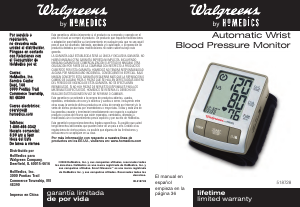
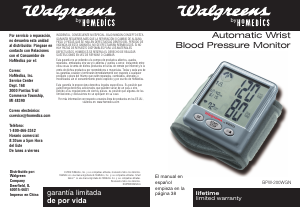

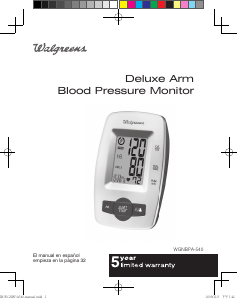
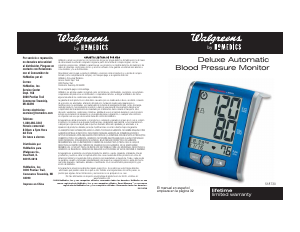
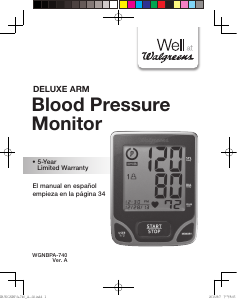
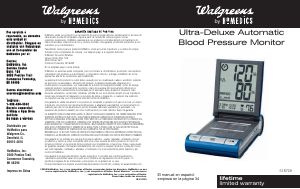
Join the conversation about this product
Here you can share what you think about the Walgreens WGNBPW-200 Blood Pressure Monitor. If you have a question, first carefully read the manual. Requesting a manual can be done by using our contact form.